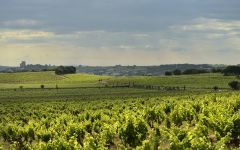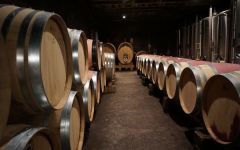Domaine de la Solitude Chateauneuf-du-Pape 2018
-
Wine
Enthusiast -
Wine
Spectator -
Robert
Parker -
Jeb
Dunnuck



Product Details
Your Rating
Somm Note
Winemaker Notes
Nose, garrigue bouquet, cistus flower, blackcurrant buds, all fresh and balanced on the palate, with aromas of cocoa and cherry, with a long finish of licorice.
In its youth, this vintage is perfect to pair with a shoulder of lamb slow roasted in oven, roast pigeon with porcini mushroom, and from its fifth year, stew, Daube Provencal, all game and many cheeses.
Blend: 50% Grenache, 25% Syrah, 25% Mourvedre, 10% Cinsault
Professional Ratings
-
Wine Enthusiast
Camphor and smoked tea subtly accent black currant and cherry in this blend of Grenache (50%), Syrah (25%), Mourvédre (15%) and Cinsault (10%). While full in feel and concentrated, it’s a fruit-focused, immediately enjoyable expression of this domaine at peak now through 2030.
-
Wine Spectator
Solidly built, with red licorice threads wrapped around a core of steeped plum and concentrated raspberry compote flavors. Apple wood and garrigue hints streak the finish, with the fruit keeping pace. Grenache, Syrah, Mourvèdre and Cinsault. Best from 2023
-
Robert Parker's Wine Advocate
Solitude's 2018 Chateauneuf du Pape is 50% Grenache, 25% Syrah, 15% Mourvèdre and 10% Cinsault, aged in a combination of barriques, demi-muids, foudres and concrete (only one-fourth went into wood). For the vintage, it shows a fair bit of structure, with fine-grained tannins framing notes of black cherries, dark chocolate and various dried spices. Medium to full-bodied, it's not the biggest wine of the vintage but is a nicely balanced, reasonably traditional example of Châteauneuf du Pape.
-
Jeb Dunnuck
Moving to the reds and based on 50% Grenache, 25% Syrah, 15% Mourvèdre, and the rest Cinsault and Counoise, the 2018 Châteauneuf Du Pape shows the vintage beautifully with its upfront, Provençal, incredibly charming personality. Loaded with ripe cherry and more red berry fruits as well as plenty of peppery garrigue and spice, it’s medium-bodied and has light tannins, terrific overall balance, and a great finish. It’s already impossible to resist, and I suspect it will be best enjoyed over the coming 10-12 years.
Other Vintages
2021-
James
Suckling -
Wine
Enthusiast -
Jeb
Dunnuck
-
Robert
Parker -
Jeb
Dunnuck -
Wine
Spectator
-
Wine
Spectator -
James
Suckling -
Jeb
Dunnuck -
Wine &
Spirits
-
Wine
Enthusiast -
Wine
Spectator -
Jeb
Dunnuck -
Robert
Parker
-
Robert
Parker -
James
Suckling -
Jeb
Dunnuck
-
Wine
Spectator -
Robert
Parker -
Wilfred
Wong -
James
Suckling
-
Robert
Parker
-
Wine
Spectator -
Robert
Parker






In the 1980s, brothers Michel and Jean Lançon took the future of Domaine de la Solitude in their hands, focusing attention on the vineyards. Fertilizers have not been used at Solitude for the past ten years. Over the past several years, Michel’s son Florent Lançon has been taking over the day-to-day operations of Domaine de la Solitude, continuing to make improvements while preserving the traditions of his father and uncle. The Estate is a contiguous 100 acres, planted to 86 acres of red grapes and 14.8 acres of white grapes, with vines averaging 50 years of age.
Driven by the desire to produce the best possible wines while still respecting the traditions of Chateauneuf-du-Pape and their lineage, in 1999, Michel and Jean decided to introduce four prestige cuvées and added Cuvée Barberini Rouge, Cuvée Barberini Blanc, Réserve Secrète, and Cornelia Constanza to the winery’s production.

With bold fruit flavors and accents of sweet spice, Grenache, Syrah and Mourvèdre form the base of the classic Rhône Red Blend, while Carignan, Cinsault and Counoise often come in to play. Though they originated from France’s southern Rhône Valley, with some creative interpretation, Rhône blends have also become popular in other countries. Somm Secret—Putting their own local spin on the Rhône Red Blend, those from Priorat often include Merlot and Cabernet Sauvignon. In California, it is not uncommon to see Petite Sirah make an appearance.

Famous for its full-bodied, seductive and spicy reds with flavor and aroma characteristics reminiscent of black cherry, baked raspberry, garrigue, olive tapenade, lavender and baking spice, Châteauneuf-du-Pape is the leading sub-appellation of the southern Rhône River Valley. Large pebbles resembling river rocks, called "galets" in French, dominate most of the terrain. The stones hold heat and reflect it back up to the low-lying gobelet-trained vines. Though the galets are typical, they are not prominent in every vineyard. Chateau Rayas is the most obvious deviation with very sandy soil.
According to law, eighteen grape varieties are allowed in Châteauneuf-du-Pape and most wines are blends of some mix of these. For reds, Grenache is the star player with Mourvedre and Syrah coming typically second. Others used include Cinsault, Counoise and occasionally Muscardin, Vaccarèse, Picquepoul Noir and Terret Noir.
Only about 6-7% of wine from Châteauneuf-du-Pape is white wine. Blends and single-varietal bottlings are typically based on the soft and floral Grenache Blanc but Clairette, Bourboulenc and Roussanne are grown with some significance.
The wine of Chateauneuf-du-Pape takes its name from the relocation of the papal court to Avignon. The lore says that after moving in 1309, Pope Clément V (after whom Chateau Pape-Clément in Pessac-Léognan is named) ordered that vines were planted. But it was actually his successor, John XXII, who established the vineyards. The name however, Chateauneuf-du-Pape, translated as "the pope's new castle," didn’t really stick until the 19th century.
